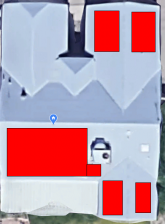36 285W panels recently acquired from Santan. Stickers intact, so not restricted to off-grid.
Know enough to be dangerous with off-grid and have only a superficial vague understanding of grid-tie at the moment.
South facing roof is messy and won't accommodate all of the panels. Some shading issues too from a roof mounted heat pump pack and other protrusions.
Considering 12kW grid-tie string inverter with up to 53A input (Fromius? locally available on CL).
4 parallel strings:
9 panels on south facing roof
9 panels on south facing roof (yes, same spot, but one will be for where shading will be more of an issue with the other in the clear)
9 panels on east facing roof
9 panels on west facing roof
Max current will be under 40A.
My thinking is that using 9 panels per string sets a very similar voltage for each string with varying current, so they'll play nicely in parallel.
Rough layout, North is up:

The E/W front and back angles are a little different. I'm sure this matters, but I suspect it isn't a huge deal. If it is a huge deal, I could use the other roof over the garage as it's the same as the one in the back.
@Hedges @SolarQueen @??????? plz?
Thanks in advance.
Know enough to be dangerous with off-grid and have only a superficial vague understanding of grid-tie at the moment.
South facing roof is messy and won't accommodate all of the panels. Some shading issues too from a roof mounted heat pump pack and other protrusions.
Considering 12kW grid-tie string inverter with up to 53A input (Fromius? locally available on CL).
4 parallel strings:
9 panels on south facing roof
9 panels on south facing roof (yes, same spot, but one will be for where shading will be more of an issue with the other in the clear)
9 panels on east facing roof
9 panels on west facing roof
Max current will be under 40A.
My thinking is that using 9 panels per string sets a very similar voltage for each string with varying current, so they'll play nicely in parallel.
Rough layout, North is up:

The E/W front and back angles are a little different. I'm sure this matters, but I suspect it isn't a huge deal. If it is a huge deal, I could use the other roof over the garage as it's the same as the one in the back.
@Hedges @SolarQueen @??????? plz?
Thanks in advance.
Last edited:


